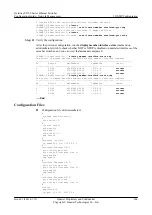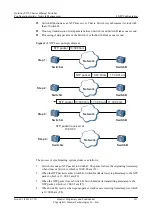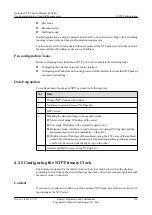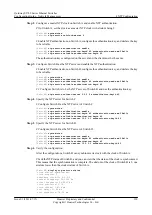
ip-address
is the IP address of the NTP peer. It can be the IP address of a host address
rather than a broadcast address, a multicast address, or the IP address of the reference
clock.
NOTE
After the NTP peer is specified, the local switch runs in symmetric active mode. The symmetric
passive end need not be configured.
l
(Optional) Configuring the Source Interface of the NTP Symmetric Passive End
1.
Run:
system-view
The system view is displayed.
2.
Run:
ntp-service source-interface
vlanif
vlan-id
The local source interface that sends NTP packets is specified.
Commonly, specify the IP address of the NTP server on the client. The client and
server can then exchange NTP packets using this IP address
If the source interface to send NTP packets is specified on the symmetric active end,
the IP address of the NTP peer configured on the symmetric passive end should be
the same; otherwise, the passive end cannot process NTP packets sent from the active
end and clock synchronization fails.
----End
4.3.5 Configuring the Broadcast Mode
This part describes how to configure the NTP broadcast mode on the LAN to synchronize clocks
on the LAN.
Procedure
l
Configuring an NTP Broadcast Server
Do as follows on the switch functioning as an NTP broadcast server:
1.
Run:
system-view
The system view is displayed.
2.
Run:
vlan
vlan-id
A VLAN is created and the VLAN view is displayed.
3.
Run:
interface vlanif
vlan-id
The interface that sends NTP broadcast packets is specified.
4.
Run:
ntp-service broadcast-server
[
authentication-keyid
key-id
|
version
number
]*
The local switch is set as an NTP broadcast server.
Quidway S2700 Series Ethernet Switches
Configuration Guide - Network Management
4 NTP Configuration
Issue 01 (2011-07-15)
Huawei Proprietary and Confidential
Copyright © Huawei Technologies Co., Ltd.
217
















































